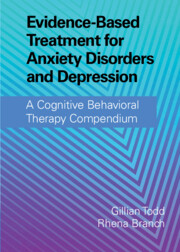 Evidence-Based Treatment for Anxiety Disorders and Depression
Evidence-Based Treatment for Anxiety Disorders and Depression from Part One - Cognitive Behavioral Therapy for Anxiety Disorders
Published online by Cambridge University Press: 06 January 2022
Somatic symptom disorder (SSD) entails a preoccupation with one or more physical symptoms that are attributed to a nonpsychiatric disease. Research on treatment for SSD supports the use of cognitive behavioral therapy (CBT) for reducing symptomatology and improving physical functioning and quality of life. This chapter summarizes the research base for CBT for SSD and provides a clinical guide to formulating, assessing, and implementing CBT for clients with SSD. Assessment requires ruling out organic medical conditions and assessing triggers of SSD, beliefs about body sensations, and associated safety behaviors. The use of a functional assessment and self-monitoring aids in developing an idiosyncratic case conceptualization. Treatment includes psychoeducation, cognitive restructuring to challenge beliefs about bodily sensations, a mix of interoceptive, in vivo, and imaginal exposure, and the elimination of all safety behaviors. The chapter concludes with a summary of recent advances in treatment of SSD, including mindfulness-based approaches.
To save this book to your Kindle, first ensure [email protected] is added to your Approved Personal Document E-mail List under your Personal Document Settings on the Manage Your Content and Devices page of your Amazon account. Then enter the ‘name’ part of your Kindle email address below. Find out more about saving to your Kindle.
Note you can select to save to either the @free.kindle.com or @kindle.com variations. ‘@free.kindle.com’ emails are free but can only be saved to your device when it is connected to wi-fi. ‘@kindle.com’ emails can be delivered even when you are not connected to wi-fi, but note that service fees apply.
Find out more about the Kindle Personal Document Service.
To save content items to your account, please confirm that you agree to abide by our usage policies. If this is the first time you use this feature, you will be asked to authorise Cambridge Core to connect with your account. Find out more about saving content to Dropbox.
To save content items to your account, please confirm that you agree to abide by our usage policies. If this is the first time you use this feature, you will be asked to authorise Cambridge Core to connect with your account. Find out more about saving content to Google Drive.